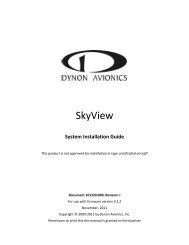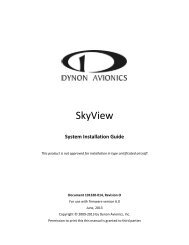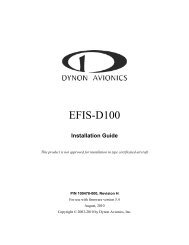EFIS-D60 Installation Guide - Dynon Avionics
EFIS-D60 Installation Guide - Dynon Avionics
EFIS-D60 Installation Guide - Dynon Avionics
You also want an ePaper? Increase the reach of your titles
YUMPU automatically turns print PDFs into web optimized ePapers that Google loves.
AppendixAppendix B: <strong>Dynon</strong> AOA/Pitot <strong>Installation</strong> and CalibrationThank you for your purchase of <strong>Dynon</strong>’s AOA/Pitot Probe. This guide walks you through thesteps to install and calibrate both the heated and unheated versions of the AOA/Pitot Probe.While the probe senses standard pitot pressure, allowing it to work with any standard airspeedindicator, its AOA functionality is designed specifically to work with <strong>Dynon</strong>’s <strong>EFIS</strong> series ofproducts. Do not expect it to work properly with another AOA system.To ensure accuracy, it is very important that you install the probe correctly and perform thespecified calibration steps. We recommend that you read the entire guide before proceeding withthe installation.<strong>Dynon</strong>’s Heated AOA/Pitot Probe is nickel-plated. Do not polish the probe as this will cause thefinish to come off.AOA CALCULATION: PRINCIPLES OF OPERATION<strong>Dynon</strong> <strong>Avionics</strong>’ AOA/Pitot probe performs two functions: airspeed sensing and angle of attacksensing. These functions require two pressure ports on the tip of the probe. The normal pitotpressure port is on the front face of the probe and is designed to be insensitive to angle of attack.The second pressure port is located on an angled surface just under the pitot port and is designedto be very sensitive to AOA. The <strong>EFIS</strong>-<strong>D60</strong> then uses the difference between these two pressuresto calculate the current angle of attack.HEATING: PRINCIPLES OF OPERATIONThe heated version of <strong>Dynon</strong>’s AOA/Pitot Probe utilizes a heating mechanism unlike any otherheated pitot on the market. The probe is heated by a high-quality nichrome heating elementwhose temperature is accurately measured and regulated by the heater controller. This controller– located in an enclosure which can be mounted in a wing or elsewhere – regulates the heat at thetip of the probe to a constant temperature. There are several advantages to this, including: lowerpower consumption, increased heating element lifespan, and a much cooler pitot on the groundwhen de-icing is not necessary. This unique technique ensures that the pitot can be rapidly deicedwhen required, but does not needlessly waste electricity when not in icing conditions.While the probe does not operate like a normal heated pitot, it will still get fairly hot in normalambient temperatures. When turned on, it will regulate its internal temperature to about 70°C to80°C. To ensure that the heater is working, briefly touch the end of the pitot farthest from thesnout after 1 minute of operation and verify that it is warm.FAILURE WARNINGDesigned to meet the indication requirements of FAR 23.1326, the heated pitot controller has anoutput that can trigger a warning light in the cockpit whenever the probe heater is turned off or isnot functioning properly. While not required for Experimental and LSA category aircraft, thisfeature provides peace of mind, giving you instant feedback that your probe’s heater is workingas designed.TOOLS AND MATERIALS REQUIRED• <strong>Dynon</strong> <strong>Avionics</strong> AOA/Pitot probe.<strong>EFIS</strong>-<strong>D60</strong> <strong>Installation</strong> <strong>Guide</strong> 5-7
















